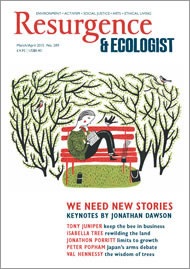Vita Sackville-West, who declared that we become “bewitched” when we see spring “flow down the woods and stipple leaves with sun...”, was veritably spot-on. Someone who is particularly prone to this bewitchment is the woodland historian, archaeologist and biographer Max Adams, whose magical evocation of trees and woods is so vivid, so luminous that you can almost smell the loam, sap and leaf-mould wafting from his engrossing pages.
Like Henry Thoreau in the 1840s, Adams has lived in the woods, but with his partner and baby son, relishing the weather, the seasons and the capricious pace of Nature. He busied himself with billhook, chainsaw and compost privy, marvelled at the beauty of trees, and coppiced and chopped for timber, charcoal and firewood. Idyllic times? Well, almost... Until his partner quit after two years, leaving him to cope and be bewitched single-handed for a year until the local planning officer became troublesome. As he ruefully explains, “it wasn’t the woodland living that was wrong, it was the wrong wood.”
However, the woodland knowledge and skills that Adams accumulated suggest that what he doesn’t know about trees would scarcely fill a small acorn. His book is titled The Wisdom of Trees, not because trees are wise, but because we would be wise to learn from them, he says.
Our affinity with trees is mysterious and complex. People have thought that trees span the chasm between the underworld and heaven, between birth and death, are dwelling places for the gods, or house the spirits of the dead. We stand beneath giant trees gazing in awe, aware that our great, vaulted cathedrals are merely stone imitations of forests.
Like all living things, trees breathe and reproduce, but, having no brain or nervous system, they can neither think nor feel pain as we know it. But, brain or not, trees are biological marvels. Adams describes their intricate chemistry, their leaves – “small miracles of physics and construction”, amazing little solar panels that soak up light. Having evolved and adapted over the last 200 million years, trees are more resilient than any animal; some live for several thousand years, and there are 60,000 known species worldwide. Nature’s living fossil, Ginkgo biloba, is 270 million years old as a species, and is one of the few trees that survived the Hiroshima blast in 1945. Adams says: “Trees are the Earth’s chest hairs: they give you about 3 degrees of warmth in winter and a commensurate cooling effect in summer,” and he suggests that by studying trees we can learn about survival, defence, sustainability, conservation and the endless creative possibilities of Nature.
Fascinating facts flow between the anecdotes and exquisite full-page illustrations. We discover that wilting May blossom emits a corpse-like odour. That the traditional name for a pole-lathe turner is ‘bodger’. That Jimmy Carter, 39th president of the United States, is a gifted woodcarver who recently sold one of his cabinets, made from persimmon wood from his own garden, for a million dollars donated to his human-rights charity.
To keep readers on their toes Adams sometimes introduces exciting, unfamiliar words like phloem, cambium, skeuomorphism and crucks, and often his prose becomes gloriously lyrical. For example, “There is a musk in the dense, unmoving air where flies cavort and butterflies dangle as if on invisible strings,” and “Every shade and hue in nature’s paintbox is on display, all saturated by the low sun or by each passing shower.”
Lyrical prose apart, read this superbly informative book, and you will want to be out planting acorns, apple pips and conkers, watering tender saplings and heeding the Chinese proverb, “The best time to plant a tree was 20 years ago. The next best time is now.” And, as Adams reminds us, trees trap carbon dioxide, make oxygen and filter pollutants. Trees are amazing, and it is a staggering fact that the precious woods that we now plant are planet-saving gifts for our grandchildren.







